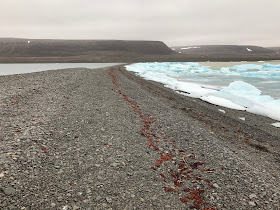 |
| Arriving at Grise Fiord for a Community Visit |
One part of nearly every Arctic adventure voyage in Canada is a visit to an Inuit community. Many of the passengers I met this past month had never before visited a northern hamlet, and weren't sure exactly what to expect. When I was working with One Ocean, we always gave a pre-visit briefing, beginning with a simple yet vital observation: Entering an Inuit community is much like entering the front door of someone's home -- someone that you are just about to meet for the first time. Under such circumstances, of course, most of us would be courteous and respectful; we wouldn't poke about our host's refrigerator or pick up family photos from the mantelpiece, certainly not without asking first. And yet, unless they're made aware of the nature of their visit, many who are traveling up north might not think twice about taking kids' photographs unasked, staring at people's homes, or wandering through the local cemetery. Thanks in large part to the briefing, the passengers I accompanied all acted appropriately, and made the most of a rare opportunity.
There are a few things nearly every such event involves: a visit to the main buildings (the hamlet's offices, the Co-Op and Northern Store, and perhaps its health center), followed by a stop at the community hall, heritage center, or wherever the cultural performance or sale of local art and crafts is to take place -- it could be, for instance, in the school gym, as it was when we visited
Grise Fiord this past August. For the expedition company, there are forms and procedures to follow; typically these will be worked out with the hamlet's Economic Development (ED) officer, and will include the hiring of local guides, payment for performers, and also for any refreshments. As with many cultural encounters, the breaking of bread (or, more often up north,
bannock) remains an important symbolic element of creating a sense of social connection. Sometimes, as with our visit to Grise Fiord, traditional Inuit "country" food is included, such as
muktuk, which is always a special treat.
And fresh
muktuk was available, as it happened because local hunters had harvested several narwhal, which they were still in the process of butchering on the beach. For some passengers, of course, this might be a bit disturbing; a decision was reached to land the zodiacs a little further up the beach, so that it wasn't the first thing the new visitors encountered. Most, when they came to understand the vital importance of traditional foods in Inuit culture, understand and respect their role. Indeed, the relatively low incidence of diabetes (among other health problems) in Grise Fiord is directly linked to that community's greater reliance on traditional, healthier food sources.
 |
| Larry Audlaluk |
For this visit, we were very fortunate that our time there was guided by
Larry Audlaluk, who is not only the town's ED officer but a leading historian, both of his own people and of polar exploration generally. One of the original group of
High Arctic Exiles in 1953, Larry took our group up to the
monument erected in 2010, which overlooks the town, and faces the direction of its companion sculpture in Resolute Bay. He recounted the many years of privation and desperation experienced by his family and community after the relocation, as well as the long and difficult journey toward making this place their home, and finally letting go of deeply-felt resentment. He pointed out his house in the town from our location, proudly noting that it's "the one with the Canadian flag." Afterward, we visited the site of the town's water supply, and attended a cultural presentation at the school gym. Although it was only a brief visit, I believe that everyone there gained a new understanding of life up north in a small settlement such as this, and a new appreciation for the history of the community.
We all, of course, like to feel sympathy for those who have endured hardship and injustice -- and we all are curious to learn more about each other. With a visit such as this, these two human impulses can begin to grow together -- after all, it's hard to care meaningfully about people you haven't gotten to know.

















